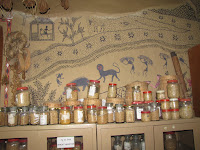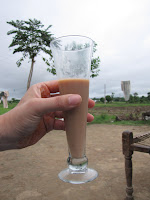
Hannah, one of the interns here, and I asked for something not so sweet for breakfast before we went to bed last night. We've been eating porridge and pancakes, which are pre-sweetened by our sugar loving cooks. So, now Sunil, Kamal and the other kitchen boys don’t know what to do with us. Half of us “angrese” like savory breakfast, half of us like sweet breakfast. So today, we had spicy peanut chutney for breakfast with paratha. Which some of us took with spicy peanut chutney (YUM) and some of us took with honey. Some of us also took it with peanut chutney and honey. Some of us took it with Nutella.

After several cups of steamy spicy sweet tea, Hannah took a few of us on a tour of the farm. Navdanya grows crops on its 54 acres for consumption on the farm, for the seedbank, and for the network of several thousand organic farmers who grow and sell organic food in India. Today we saw fields of millet, rice, taro and corn intercropped with beans, okra and peanuts. We paused for a moment in our walk right before we got to the seed bank and an eagle flew over our heads.
Navdanya is dedicated to food sovereignty through returning the control of farming to farmers through seeds. Farmers are free to take any seed from the bank, as long as the return what they took with an additional fifty percent more. They are encouraged to save their own seeds and start their own seed banks for exchange amongst themselves. There are 42 such seed banks throughout India and countless more in homes and small villages. Navdanya keeps more than 400 varieties of rice alone, and several hundred varieties of other kinds of crops. In case you don’t know, the Green Revolution in the 1960s brought hybrid seeds to India, which can’t be saved. In a few decades the indigenous varieties of crops had disappeared and farmers were dependent on buying seed from multinational companies. Navdanya returns seeds to farmers as a way to return autonomy to producers and sustainability to agriculture.

The seed bank is managed by a woman named Bija, whose name also happens to be the Hindi word for seed. Bija wasn’t working today, and we stood in the hush of the mud and brick building, in silent wonder at all the ancient wisdom accumulated in this one place. The seed bank does not appear to have a catalog in English, and upon hearing this, I knew what I would be doing for the rest of my time here. Cataloging thousands of different seeds may not be your cup of tea, but I got chills of pleasure and wonder at the thought of intimately knowing all these ancient races of grains and vegetables that came to life long before my own people even existed and which will live on past my little lifetime in the farms and fields of this amazing land.
After this awe inspiring experience, we got down and dirty and helped weed the turmeric field. Weeding turmeric! I’m not sure why this thrills me so much, but weeding anything satisfies a little bit of the OCD in me, and getting my hands in the soil in which a powerful medicine, an essential flavoring of Indian food and a sacred element of many Hindu rituals, grows is just about a peak experience for me. All of us, angrese and Indian workers alike, crowded into the kitchen afterward to share a simple meal of dal, rice, potato curry, roti and peanut chutney while sitting on the floor, trading Hindi and English jokes and laughing the whole time. So so so beautiful.

More tea and an afternoon nap, after which Hannah, an Italian guy named Masi and I went to Ramgarh, the local village to buy some mangoes for breakfast. Another curve ball for the kitchen boys. And we want yogurt with them too! We stopped for a snack because my blood sugar has done a surprising nose dive here in spite of the relentless barrage of carbohydrates morning, noon and night. I think Swami Ramji, who promised to cure me, may be chanting some mantras that are working. We had aloo tikki—a fried potato pancake served with a sweet-spicy sauce, yogurt and raw onions. Delicious.

On our way back to the farm, we saw Sunil heading to the neighbor’s farm for fresh milk. We asked to come along, as part of our scheme to get some yogurt, and when we arrived, we were invited to stay for tea. We declined, to be polite, but of course, as is the custom, we were not really given an option. Cots were pulled out, neighbors stopped by and kids piled up for pictures, and more pictures. An hour or so passed, and the monsoon clouds loomed, and I wondered if we should go. Sunil shook his head, no. So we stayed. I took some more pictures of the kids and the beautiful women, and stopped worrying and loved the rain that actually never came.


It soon came out that it was Suwan’s 13th birthday today and there was going to be a party. We hadn’t put two and two together yet, and I think the surprise birthday party was on us! We were invited into the master bedroom of the house and candles were lit and blown out, balloons popped and sweets shared. We then were told to go back to our cots in the courtyard, and one of the beautiful daughters of the house came out, laughing, with beer glasses full of tea made with the milk fresh from the cow.

Gracious, funny and loving people, living a simple life in this beautiful place. I want to stay forever. Salud!



